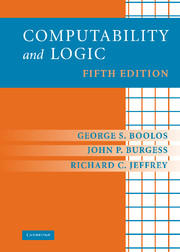Book contents
- Frontmatter
- Contents
- Preface to the Fifth Edition
- COMPUTABILITY THEORY
- 1 Enumerability
- 2 Diagonalization
- 3 Turing Computability
- 4 Uncomputability
- 5 Abacus Computability
- 6 Recursive Functions
- 7 Recursive Sets and Relations
- 8 Equivalent Definitions of Computability
- BASIC METALOGIC
- FURTHER TOPICS
- Annotated Bibliography
- Index
1 - Enumerability
Published online by Cambridge University Press: 05 June 2012
- Frontmatter
- Contents
- Preface to the Fifth Edition
- COMPUTABILITY THEORY
- 1 Enumerability
- 2 Diagonalization
- 3 Turing Computability
- 4 Uncomputability
- 5 Abacus Computability
- 6 Recursive Functions
- 7 Recursive Sets and Relations
- 8 Equivalent Definitions of Computability
- BASIC METALOGIC
- FURTHER TOPICS
- Annotated Bibliography
- Index
Summary
Our ultimate goal will be to present some celebrated theorems about inherent limits on what can be computed and on what can be proved. Before such results can be established, we need to undertake an analysis of computability and an analysis of provability. Computations involve positive integers 1, 2, 3, … in the first instance, while proofs consist of sequences of symbols from the usual alphabet A, B, C, … or some other. It will turn out to be important for the analysis both of computability and of provability to understand the relationship between positive integers and sequences of symbols, and background on that relationship is provided in the present chapter. The main topic is a distinction between two different kinds of infinite sets, the enumerable and the nonenumerable. This material is just a part of a larger theory of the infinite developed in works on set theory: the part most relevant to computation and proof. In section 1.1 we introduce the concept of enumerability. In section 1.2 we illustrate it by examples of enumerable sets. In the next chapter we give examples of nonenumerable sets.
Enumerability
An enumerable, or countable, set is one whose members can be enumerated: arranged in a single list with a first entry, a second entry, and so on, so that every member of the set appears sooner or later on the list.
- Type
- Chapter
- Information
- Computability and Logic , pp. 3 - 15Publisher: Cambridge University PressPrint publication year: 2007



